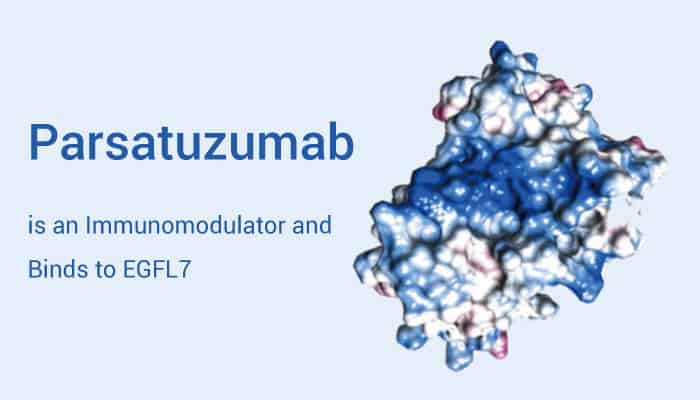Epidermal Growth Factor like domain 7 (EGFL7) is an endothelial cell-derived factor, mostly expressed in endothelial cells. EGFL7 takes part in the regulation of the spatial arrangement of cells during vascular tube assembly. The Egfl7 gene encodes active miR-126 which is related to cardiovascular diseases as well as the formation of cancer. Egfl7 specifically expresses in endothelial cell at physiological conditions, however, it aberrantly expresses in tumor cells of human cancers. In egfl7-knockdown zebrafish, vascular tubulogenesis is inhibited and the blood circulation is blocked, exhibiting pericardial oedema and hemorrhage. In vitro, EGFL7 improves cell immigration, thus, over-expression of the gene increases tumor growth and metastasis in xenograft mice. Therefore, EGFL7 is a common target for the treatment of cardiovascular diseases and cancer. Here, we will introduce an EGFL7-targeting monoclonal antibody (mAb), Parsatuzumab.
Parsatuzumab (RG 7414) is a humanized mAb, acting as an immunomodulator and binding to EGFL7.
 Mol Immunol.2019 Aug; 112:338-346.
Mol Immunol.2019 Aug; 112:338-346.
Parsatuzumab selectively blocks the interaction between EGFL7 and endothelial cells, potentially inhibiting vascular regrowth and reducing vascular endothelial growth factor (VEGF) inhibition. Besides, Parsatuzumab (48 h) inhibits cell proliferation by 70% from 20% and increases apoptosis by 67-87% from 8-17% against patient-derived xenograft (PDX) cells. Moreover, Parsatuzumab (50 mg/kg, i.v., 3 times per week) targets EGFL7 and blocks mantle cell lymphoma (MCL) cell growth, and prolongs survival in mouse models of MCL. Additionally, Parsatuzumab enhances the antiangiogenesis, tumor growth control, and survival associated with anti-VEGF monotherapy in several xenografts and genetically engineered murine tumor models. Excitingly, randomized phase II trials of Parsatuzumab are in progress.
In conclusion, Parsatuzumab is a potent EGFL7-targeting mAb, that has the potential to research anticancer and angiogenesis.
References:
[1] García-Carbonero R, et al. Oncologist. 2017 Apr;22(4):375-e30.
[2] Chinmayee Goda, et al. Blood. 138(S1), 2021:3300.